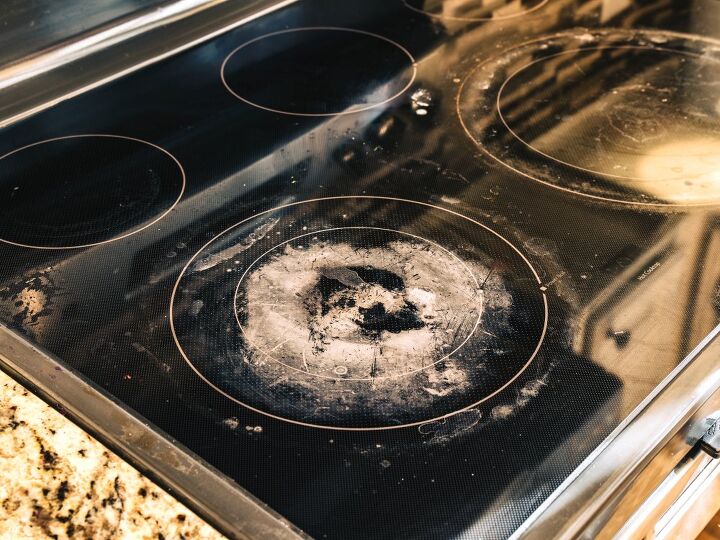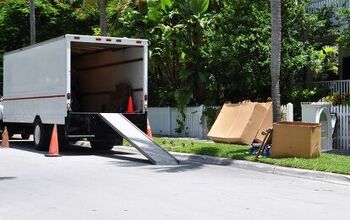How To Clean A Burnt Induction Cooktop

With their smooth, modern designs, induction cooktops can not only improve your culinary skills but also your kitchen’s aesthetic appeal. With the appropriate equipment and advice, you can quickly and thoroughly clean any surface that becomes soiled. However, there are times when it will become burnt, so what do you do? How do you clean a burnt induction stovetop?
To clean an induction stovetop, you can use white distilled vinegar, as well as some ceramic and glass cleaner to lift the stains. Be careful not to use steel wool or any harsh scrubbing tools. Apply and lightly scrub to lift the stains. Repeat any steps until the stain is fully lifted.
Having stains on your induction stove can make it unsightly. Therefore, its essential you know how to clean it in order to make it appealing to the eye. Let’s get started!
How Do You Clean a Burnt Induction Stovetop?
Glass and ceramic stovetop cleansers and cooktop cleaning kits provide everything you need to take care of your inductive cooktop surface in a more thorough manner.
Additionally, KitchenAid sells scraping tools for the stovetop that are intended to help remove debris without scratching.
It is advised to clean your ceramic glass cooktop soon after its use constantly and after it has cooled down for the best results.
Using a cleaning fluid and a damp towel, this process takes around two to five minutes. But occasionally, a thorough cleaning is required.
Your induction cooktop can be washed and prepared for your next meal in less than 30 minutes with the help of a cleaning kit, scraper, and nonabrasive pad.
Remember to read your owner’s manual before using any cleaning chemicals, and always follow the instructions on the packaging to prevent damage to your cooktop.
1. Scrape the Surface
Wait until the cooktop has cooled so that it is warm to the touch but not hot before cleaning any burnt-on oil or residue.
Holding the scraper as flatly as you can help you remove any residue without damaging the glass. As needed, repeat the operation.
Notably, heated cookware on top of an induction cooktop can still conduct heat even though the surface does not radiate heat from the cooktop itself.
Even after you’ve taken the cookware out of the oven and turned off the burner, it’s still advisable to let it cool.
2. Spray the Surface
When your stove is entirely cool to the touch, spritz a cleaning agent or a vinegar-and-water mixture over the surface.
After letting the solution sit for 10 to 15 minutes, use a soft cloth or washing pad to wipe the surface clean.
3. Apply Glass and Ceramic Cleaner
For any problematic messes, use a dollop of glass and ceramic cooktop cleaner the size of a dime. Rub the impacted areas with a soft bristle brush scrubbing pad until the substance is released. Before moving on to the following stage, let the cleaning solution dry to a hazy white film.
4. Polish the Surface
Wash and polish the cooktop area using a dry cloth. Rub continuously until the white coating is removed.
5. Repeat Steps 1 Through 4
Even after polishing, scrubbing, and scraping, messes can occasionally be challenging to remove. Simply repeat steps 1 through 4 till your stovetop area is clear if this is the situation
How Do You Maintain An Induction Cook Top?
Right after you finish using your induction stove is the ideal time to clean it. By performing this everyday maintenance, you can keep your ceramic glass stovetop smooth and shiny.
Wait until the stove has cooled before cleaning it with a wet sponge and cleaner for small or moderate spills. Use a mild cleanser and scraper to clear up any problem caused by heavy soil or tenacious residue.
What Should You Avoid Using to Clean an Induction Stovetop?
Resist using the following items in your cleaning regimen to help safeguard your induction cooktop:
- Iron wool
- Scrubbing brushes made of iron (brushes with steel bristles)
- Cleaners made of abrasive powder
- Chlorine bleach
- Rust Remover
- Ammonia
Always read your owner’s manual and the directions on your cleaning supplies before using them for the best results.
How Do You Remove White Burn Stains Off Of Your Induction Stovetop?
Use vinegar to get rid of white splotches or hard water stains on your stove. Apply a dry cloth dampened with a white vinegar mixture to the stains first.
After letting the vinegar sit for a short while, massage the spots out. Finally, rinse with distilled water or a second clean cloth and cooktop surface cleaner.
Can You Ruin an Induction Cooktop?
Due to a top glass-ceramic surface that is brittle, induction cooktops are weak. Although it is not metal, it is robust.
The surface is comprised of a tough glass-ceramic combination, which seldom breaks under normal daily use. If handled harshly, they could possibly crack or get scratched.
How Do I Clean an Old Induction Cooktop?
Use nothing that might scuff or harm the surface. Once your cooktop has been thoroughly cleaned, use some white vinegar to remove any hard water stains.
For thorough cleaning, you can also use a paper towel and a ceramic cooktop cleaner. For a deeper clean, you might use a dry cloth.
Can You Use Vinegar to Clean Induction Cooktops?
Use vinegar to get rid of white splotches or hard water stains on your stove. Apply a dry cloth dampened with a white vinegar mixture to the stains first.
After letting the vinegar sit for a short while, massage the spots out. Finally, rinse with distilled water or a fresh clean cloth and cooktop surface cleaner.
Can I Use Windex on my Induction Cooktop?
Glass cleaners like Windex should never be used. Although using a glass cleaner on a glass stovetop may seem logical, it is not an intelligent idea.
The glass cleaner’s ammonia is highly potent and may cause harm to a stove top when used to clean it. White vinegar is a superior substitute.
Can You Clean Induction Cooktop with Alcohol?
Your stove should be sprayed with 70% concentration of rubbing alcohol before being dried with a paper towel. Alcohol degrades fat and sanitizes surfaces, leaving your cooktop spotless and clean.
70% alcohol is preferable to 90% alcohol for cleaning and disinfecting surfaces since 90% alcohol evaporates too quickly.
Can You Use Dish Soap to Clean Induction Cooktop?
Are Induction Cooktops Hard to Clean?
The only section of an induction cooktop that warms up is the part that is in contact with the pot or pan, making it theoretically easier to clean than a conventional cooktop. As a result, it is less likely that food or liquid spills on the cooktop will bake there.
Can I Use Clorox Wipes on Induction Cooktop?
Are Induction Cooktops Hard to Maintain?
Most spills won’t have the opportunity to cook onto the surface because the only area of the induction cooktop that genuinely heats up is the area covered by your cookware.
There is no need for a specific cleaning solution; all that is needed is to wipe up any spills or sprays with a moist sponge or cloth.
Do Induction Cooktops Scratch Easily?

Heather is a passionate writer who loves anything DIY. Growing up, she learned everything from home repairs to design, and wants to share her tips with you. When she's not writing, she's usually hiking or searching for her next DIY project.
More by Heather Robbins













![The 10 Best Table Saws - [2022 Reviews & Buyer's Guide]](https://cdn-fastly.upgradedhome.com/media/2023/07/31/9070645/the-10-best-table-saws-2022-reviews-buyer-s-guide.jpg?size=350x220)













